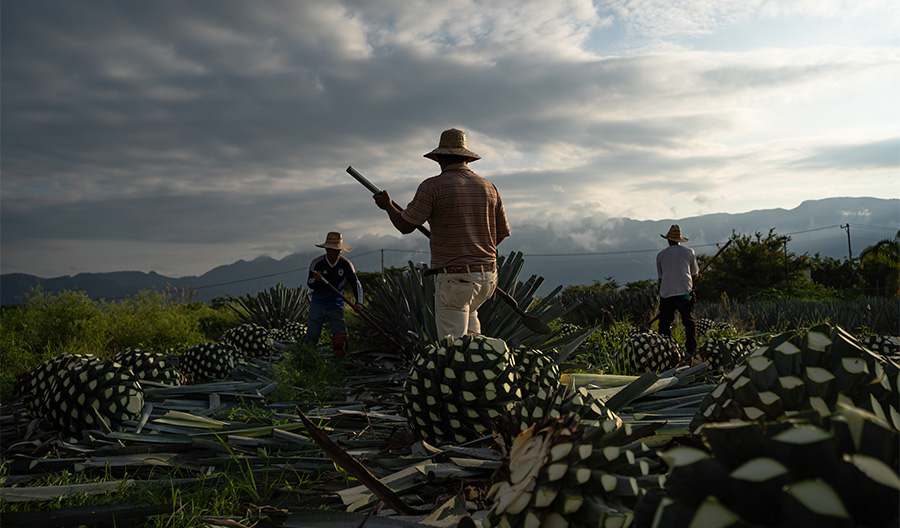The Consejo Regulador del Mezcal (CRM) was established in 1994 and regulates what can be labeled mezcal based on strict parameters, including the manner in which the spirit was produced. However, there are questions over the efficacy of the organization; many prominent producers like have opted to drop out of the process, which can pose financial barriers and limit the creativity of mezcaleros. You may very well find a bottle of mezcal that employs artisanal or ancestral practices, but which is excluded from certification for any number of reasons, from denomination of origin down to acid and aldehyde levels. That said, here are three classification labels you might find when you’re buying a mezcal bottle and what they mean—plus where destilado de agave falls into the mix.
Mezcal
Mezcal with this label can use industrialized processes and tools such as autoclaves for cooking the agave, stainless steel fermentation vessels, and continuous column stills for distillation. Industrially made mezcal likely uses many processes borrowed from the production of modern-day tequila, which can betray the spirit’s, well, spirit. The most magical thing about mezcal is that every batch is going to be different.
Mezcal Artesanal
Most registered mezcals are labeled artesanal. Cooking only takes place in pit ovens, but some modern updates to the traditional process are allowed, such as the use of copper stills for distillation instead of clay pots and mechanical shredders for grinding the agave fibers instead of wooden mallets or tahonas.
Mezcal Ancestral
For this ultra-traditional variety, producers must use clay pots fueled by fire to distill the spirit. The clay imparts a mineral-like taste to the final product, says Hernandez.
Destilado de Agave
This label refers to any agave distillate that does not meet the criteria set forth by the CRM or other regulatory agencies for spirits with a denomination of origin. It could also simply refer to a bottle from a producer who uses artisanal or ancestral mezcal practices, but has opted to forgo the often time-consuming and expensive CRM registration process.

What Is Espadín?
If you’ve ever ordered a mezcal cocktail, chances are it contained espadín. One of the common names for the angustifolia agave species, this variety makes up between 80% and 90% of the mezcal consumed worldwide. Its high concentration of sugars yields more mezcal than other varieties, and it typically takes less time to mature than other agave species, factors which render it more affordable.
Understanding Mezcal Varieties
Tobalá vs. tepeztate is just the beginning: Agave species have different common names in different mezcal regions. For instance, the agave angustifolia is most commonly known by its Oaxacan name, espadín, but it is called espadilla in Puebla. Barril and bicuixe, meanwhile, are both shorthand for the karwinskii plant. And these common names oftentimes reflect the original language of the communities that make mezcal.
The difference between a plant’s common names isn’t arbitrary, as the unique terroir of each region will affect the final product. Even within a region, flavors can vary widely based on the processes of a producer. For example, one family in Jalisco produces mezcals from 14 types of local angustifolia, and each bottle tastes completely different. With that in mind, consider the varietal guide below as an incomprehensive introduction. To really experience the spirit and its many expressions, you’ll just have to taste it.
Americana
Common names include: Arroqueño
This plant takes up to 25 years to mature. It often yields mezcals with soft, sweet, and citrusy notes.
Angustifolia
Common names include: Espadín, Espadilla, Pelón Verde, Tepemete
Up to 90 percent of the mezcal on the market is made with this plant: It takes just six to eight years to mature, and as such is more easily cultivated than other varieties. Angustifolia is an ancestor of agave tequilana (otherwise known as blue Weber agave, aka the stuff in tequila), and during a tequila shortage in the early 2000s, espadín was often swapped in for the spirit.
Karwinskii
Common names include: Baicuishe, Barril, Cuishe, Madre Cuishe, Pacheco, Tobaziche, Verde
This species typically yields smaller batches of liquid, which are earthy and mineral-like. The flavor can be compared to sal de gusano, the worm salt that is often served alongside mezcal.
Marmorata
Common names include: Pichumel, Tepeztate
The marmorata plant famously takes up to 35 years to mature. All that time in the ground yields spicy and intense flavors such as peppercorn and cinnamon. Of course, flavors can vary.
Potatorum
Common names include: Papolome, Tobalá
Sometimes known as the “king” of mezcal, this small-but-mighty variety is best known for its characteristic sweetness—and its hefty price tag. Unlike other varieties, potatorum can only grow from seeds (others can grow from genetic clones of an agave).
Rhodocantha
Common names include: Cuixe, Mexicano
This relatively rare varietal can be described as floral and likens the sweet finish to cooked agave nectar.
Ensambles
Mezcal blends, called ensambles, include multiple varieties of agave. These blends are true to the spirit of mezcal, as producers would historically use whatever agave was available to them in their expressions.

